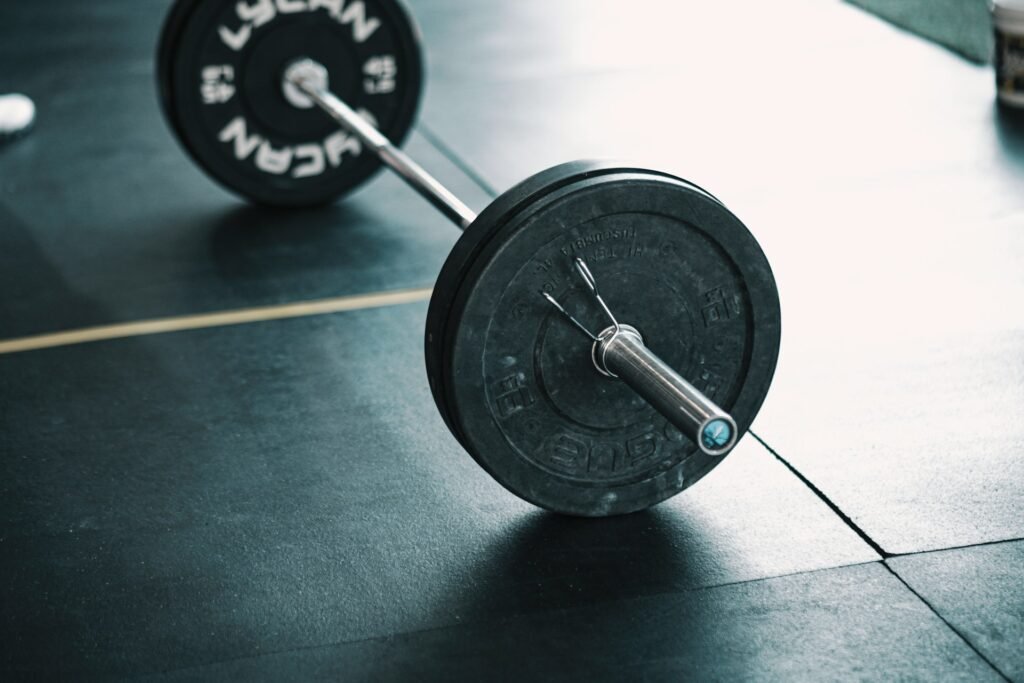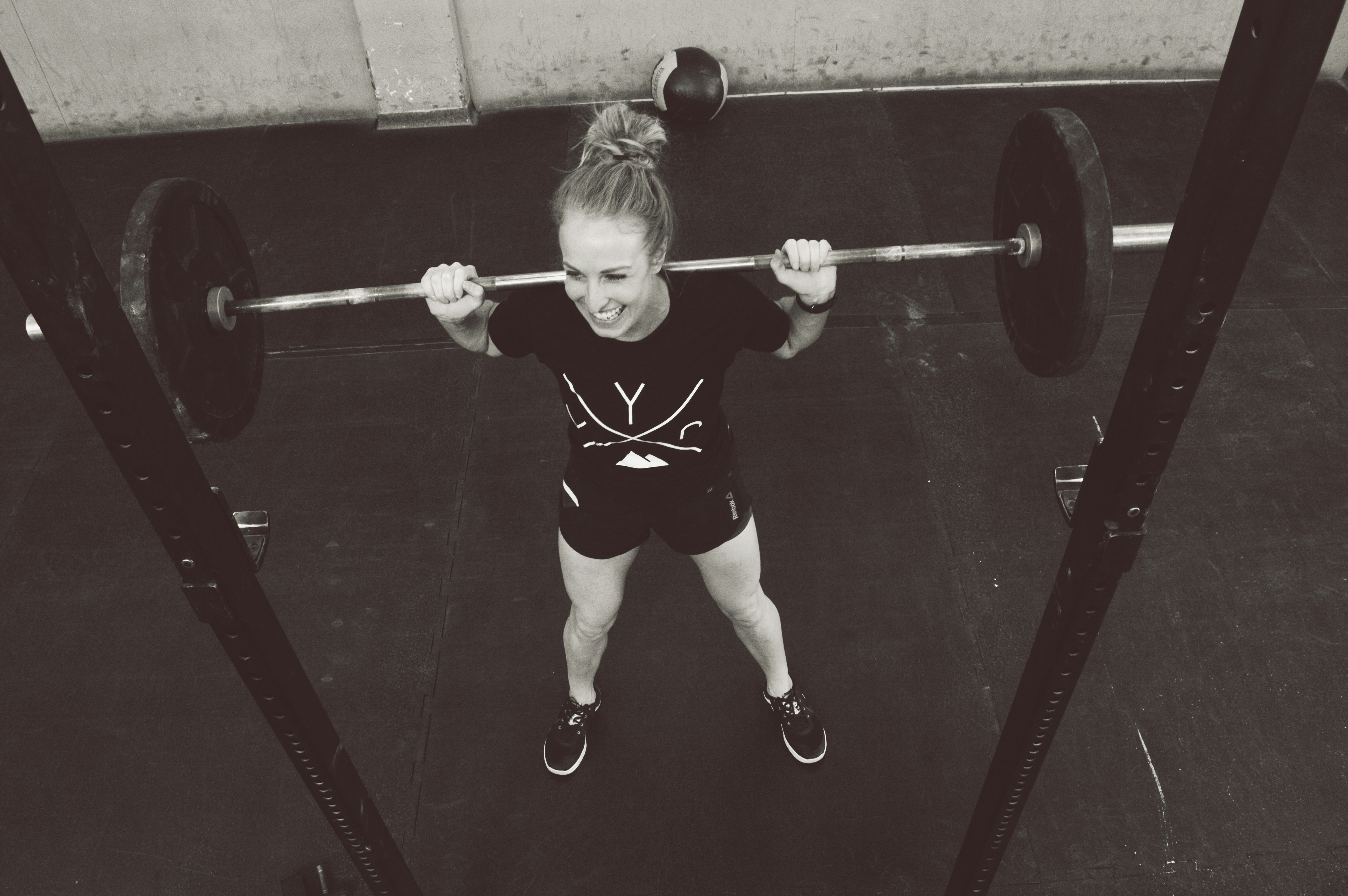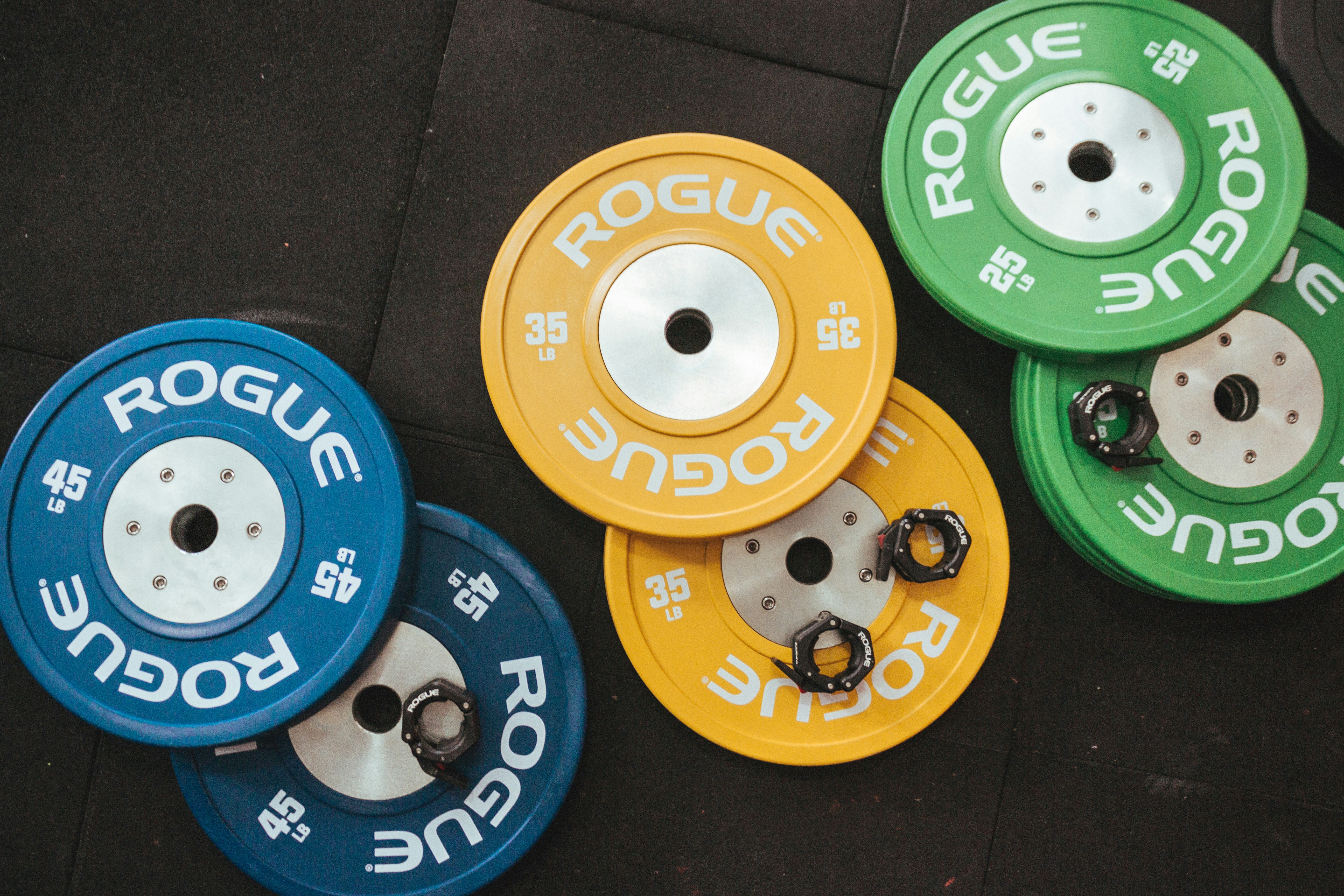
Photo by Eduardo Cano Photo Co. on Unsplash
Barbell leg workouts are a cornerstone of strength training for good reason. One of the primary benefits of using a barbell for leg exercises is the ability to progressively increase the weight, allowing for continuous strength gains and muscle hypertrophy. For example, barbell squats target major muscle groups, including the quadriceps, hamstrings, and glutes, making it one of the most effective exercises for overall lower body strength.
A study published in the Journal of Strength and Conditioning Research found that compound exercises like barbell squats significantly improve lower body power and strength compared to machine-based exercises [^1^]. Moreover, incorporating barbell exercises can boost your metabolic rate due to the large muscle groups involved, which aids in fat loss and endurance.
Additionally, barbell leg exercises can enhance functional fitness by mimicking natural movement patterns used in daily activities. This not only improves athletic performance but also reduces the risk of injury. The use of a barbell also offers versatility, allowing for a variety of exercises such as deadlifts, lunges, and hip thrusts, each targeting different muscle groups within the legs.
Starting with lighter weights and gradually increasing allows for safe progression whether you are a beginner or an advanced lifter. If you need some variations or supplementary cardio exercises to complement your leg day, you might find some valuable tips in our guide on steady-state cardio.
[^1^]: ProsourceFit: 8 Barbell Leg Exercises to Strengthen Your Legs
Benefits of Using a Barbell for Leg Workouts
Using a barbell for leg workouts offers multiple advantages that can help improve strength and overall fitness. One of the significant benefits is the ability to lift heavier weights compared to dumbbells or kettlebells. This increased resistance can lead to greater muscle hypertrophy and strength gains. Research shows that performing squats with a barbell can increase your maximum power output by nearly 20% compared to using other forms of resistance (Layne Norton, PhD).
Another advantage is the versatility of barbell exercises. With a single piece of equipment, you can perform a wide array of exercises such as squats, deadlifts, and lunges, targeting different muscle groups and angles. This helps in developing well-rounded lower body strength.
Barbell workouts also engage stabilizing muscles more effectively. When performing compound movements like squats, your core, back, and even upper body muscles get activated to maintain balance and proper form. This not only enhances muscle coordination but also improves functional fitness, which is beneficial for daily activities and sports.
In addition to these benefits, barbell workouts offer a more time-efficient training session. Since you can lift heavier weights and engage multiple muscle groups at once, workouts can be shorter yet more effective.
Finally, training with a barbell for leg workouts can help in better measuring progress. You can easily track the weights lifted and steadily increase the load, ensuring continuous development.
For those who are looking to optimize their training routine, it’s also essential to consider other forms of cardio workouts. Check out our guide on steady-state cardio examples to complement your leg day.
Warm-Up Routines to Prevent Injury
A proper warm-up is essential for preventing injuries during your barbell leg workout. Research shows that warming up can reduce the likelihood of injuries such as muscle tears and sprains. Warm-up exercises gradually increase your heart rate and improve blood flow to your muscles, which “wake up” and prepare for the upcoming intense activity. Without a warm-up, muscles can be caught off guard by the sudden strain, increasing the risk of tissue damage and other injuries (source).
Here are five effective warm-up exercises to ensure a safe and productive workout:
- Arm Reach: Stand with legs hip-width apart. Swing your right arm across your chest while rotating to the left, then switch sides. Perform for 20 to 60 seconds on each side.
- Knee Lift: Stand with legs wider than hip-width and place your hands behind your head. Lift your left knee to touch your left elbow, then repeat on the right side. Continue for 20 to 60 seconds per side.
- Lateral Lunge With Arm Reach: With feet wider than shoulder-width, extend your right arm to touch your left foot while bending your left knee. Switch sides and repeat for 20 to 30 seconds each.
- Squats: Stand with legs apart, shift your hips back, and bend your knees. Ensure your knees stay behind your toes. Perform squats for 20 to 60 seconds.
- Plank Stretch: Bend down to walk your hands forward until your body is parallel to the floor, keeping your core tight. Walk your hands back to your feet and stand up. Repeat for 20 to 60 seconds.
For more detailed information on warm-up exercises, you might find the article on effective low-impact cardio for bad knees beneficial, especially if you require gentle yet effective warm-up routines.
Top Barbell Exercises for Leg Day

Photo by Lucy Dunne on Unsplash
Barbell Back Squat
The barbell back squat is the cornerstone of any leg workout. Known as the king of lower body exercises, it targets the quads, hamstrings, and glutes. By allowing you to lift heavy weights, it helps increase muscle mass and bone density. Research has shown that squats can significantly boost growth hormone levels, aiding muscle growth and strength [^1].
Barbell Front Squat
The barbell front squat emphasizes the quads and core more than the back squat. It’s particularly useful for those with lower back issues due to its upright torso position, which reduces the compressive load on the spine.
Barbell Romanian Deadlift (RDL)
RDLs are excellent for targeting the hamstrings and glutes. Unlike the conventional deadlift, the RDL focuses on the hip hinge movement, keeping constant tension on the muscles. This exercise is beneficial for improving muscle mass and strength in the posterior chain [^2].
Barbell Split Squat
The barbell split squat focuses on reducing muscle imbalances between legs, targeting the quads and glutes. This unilateral exercise enhances muscle symmetry and can improve overall leg strength, benefiting your squat and deadlift performance.
Barbell Hip Thrust
Hip thrusts are the go-to exercise for isolating the glutes. This movement targets the glutes through horizontal hip extension, which is different from vertical movements like squats and deadlifts. Studies have shown that hip thrusts significantly activate the glutes more than other lower body exercises [^3].
For more detailed guides on various exercises and their benefits, you might find our article on different types of squats insightful.
[^1]: “High-repetition squats significantly increase growth hormone levels,” Journal of Sports Science and Medicine, 2020. [^2]: “Effects of Romanian Deadlifts on posterior chain muscles,” Strength and Conditioning Journal, 2021. [^3]: “Glute Activation in Hip Thrusts vs Squats,” Journal of Training Research, 2019.
You can read more about other effective lower body exercises in our article on barbell leg workouts.
Structuring Your Weekly Leg Workout
Creating a well-rounded weekly leg workout is crucial for balanced muscle development and overall strength. Begin by determining whether you prefer a split routine or incorporating leg exercises into total body workouts. Both methods are effective, but the choice depends on your personal goals, schedule, and endurance.
Warm-Up Routine:
Before diving into your main lifts, it’s essential to start with a thorough warm-up to prevent injury. A typical warm-up could include foam rolling, glute activation exercises, core activation, and dynamic stretches. Warm-up sets at 50-75% of your working weight for each major lift will also help prepare your muscles.
Main Lifts and Movements:
A balanced leg workout should target different muscle groups and movement patterns. Here’s a sample structure using a split routine:
Week 1:
- Big Squat Pattern (Back Loaded): Back Squat
- Big Hip Hinge (Front Loaded): Barbell Deadlift, Hip Thrust, or Kettlebell/Dumbbell Deadlift
- Single Leg Knee Dominant (Side Loaded): Split Squats, Reverse Lunges, or Step Ups
- Optional Movements: Lateral or Transverse Lunges/Step Ups for sports specificity
- Isolation Movements: Quad extensions and hamstring curls after compound lifts to target specific muscles.
Week 2:
- Big Squat (Front Loaded): Goblet Squat or Front Squat
- Big Hip Hinge (Side Loaded): HEX Bar Deadlift
- Single Leg Hip Dominant (Various Load): Single Leg Deadlifts or Good Mornings
- Optional Movements: Sports-specific exercises like lateral or transverse lunges
- Isolation Movements: Focus on specific muscle groups with machines like leg press after compound movements.
Picking Reps and Sets:
- General Fitness: 12 reps, 3 sets
- Weight Loss and Endurance: 15-20 reps, 2-3 sets
- Hypertrophy: 10 reps, 4-6 sets
- Strength: 3-8 reps, 4-6 sets
Ways to Progress:
Changing your exercises every 6-12 weeks helps avoid plateaus. Adjust the load amount, volume, load placement, tempo, and planes of motion to progress effectively. For example, increasing the weight, adding more sets, or modifying your rep speed can all stimulate muscle adaptation.
A consistent program is key to seeing results. Document your routine and track your progress in a notebook or digital app.
For added variety, check out our at-home dumbbell leg workout.
For more on how to build an effective leg workout, check resources like Jonathan Jordan’s blog.
By following these guidelines, you’re setting yourself up for a robust and effective leg workout each week.
Common Mistakes to Avoid

Photo by Victor Freitas on Unsplash
Even with the best intentions, mistakes can happen during barbell leg workouts. Here are some common errors to be aware of and how to avoid them:
- Poor Form: Incorrect form can lead to injuries and less effective workouts. For instance, bending your back during squats is a common mistake that can strain your spine. Always focus on keeping your back straight and your core engaged.
- Neglecting Warm-ups: Skipping warm-ups is a dangerous habit. According to a study by the American Council on Exercise, warming up before workouts can reduce the risk of injury by up to 79% ACE Fitness. Simple activities like dynamic stretches or light cardio can prepare your muscles for the workout.
- Overloading Weights: While lifting heavier weights can be tempting, it can also increase the likelihood of injury if your body isn’t ready. Increase your weights gradually and ensure you can maintain proper form with each lift.
- Not Following a Balanced Routine: Focusing only on one type of exercise or muscle group can create imbalances that affect your overall strength and stability. A well-rounded workout should include a variety of exercises like squats, lunges, and deadlifts.
- Ignoring Recovery Time: Muscle recovery is crucial for growth and preventing injuries. According to research published in the Journal of Strength and Conditioning Research, muscles need 48 hours to recover fully after a strenuous workout J Strength Cond Res. Ensure you allow yourself adequate rest between leg workouts.
Avoid these common mistakes to ensure you get the most out of your barbell leg workouts effectively and safely. For more insights on balancing different types of exercises, check out our guide on at-home dumbbell leg workouts.
Final Thoughts on Barbell Leg Workouts
Barbell leg workouts are an excellent addition to any fitness routine, providing a multifaceted approach to strengthening your lower body. These exercises not only build essential muscle groups like the quadriceps, hamstrings, and glutes but also enhance overall functional fitness. For instance, squats and deadlifts are cornerstone movements in weightlifting and are known for their ability to improve balance, stamina, and core strength.
If you’re consistent with your barbell leg workouts, you can expect to see significant gains. Data suggests that compound lifts, like those often incorporated into barbell routines, can increase muscle mass by up to 40% in a year when paired with proper nutrition and rest source.
Moreover, barbell leg exercises offer flexibility in structuring your workouts. You can choose from a variety of movements to keep your routines engaging and effective, such as Romanian deadlifts, Bulgarian split squats, and standard barbell squats. Each of these exercises targets different muscle groups, ensuring comprehensive lower body development.
Avoiding common mistakes, like improper form or overloading the bar, is crucial for maximizing results and preventing injuries. Simple precautions, such as thorough warm-up routines and regular checks on your lifting technique, can make a significant difference in your progress and safety.
Having a weekly structure and staying committed to it can help you achieve your fitness goals. For more insights on related topics, check out our article on how much cardio is optimal when trying to build muscle here.
In summary, barbell leg workouts offer tremendous benefits for muscle growth and overall fitness. Whether you’re a beginner or an advanced lifter, incorporating these exercises into your regimen can lead to lasting improvements in strength and physical health.